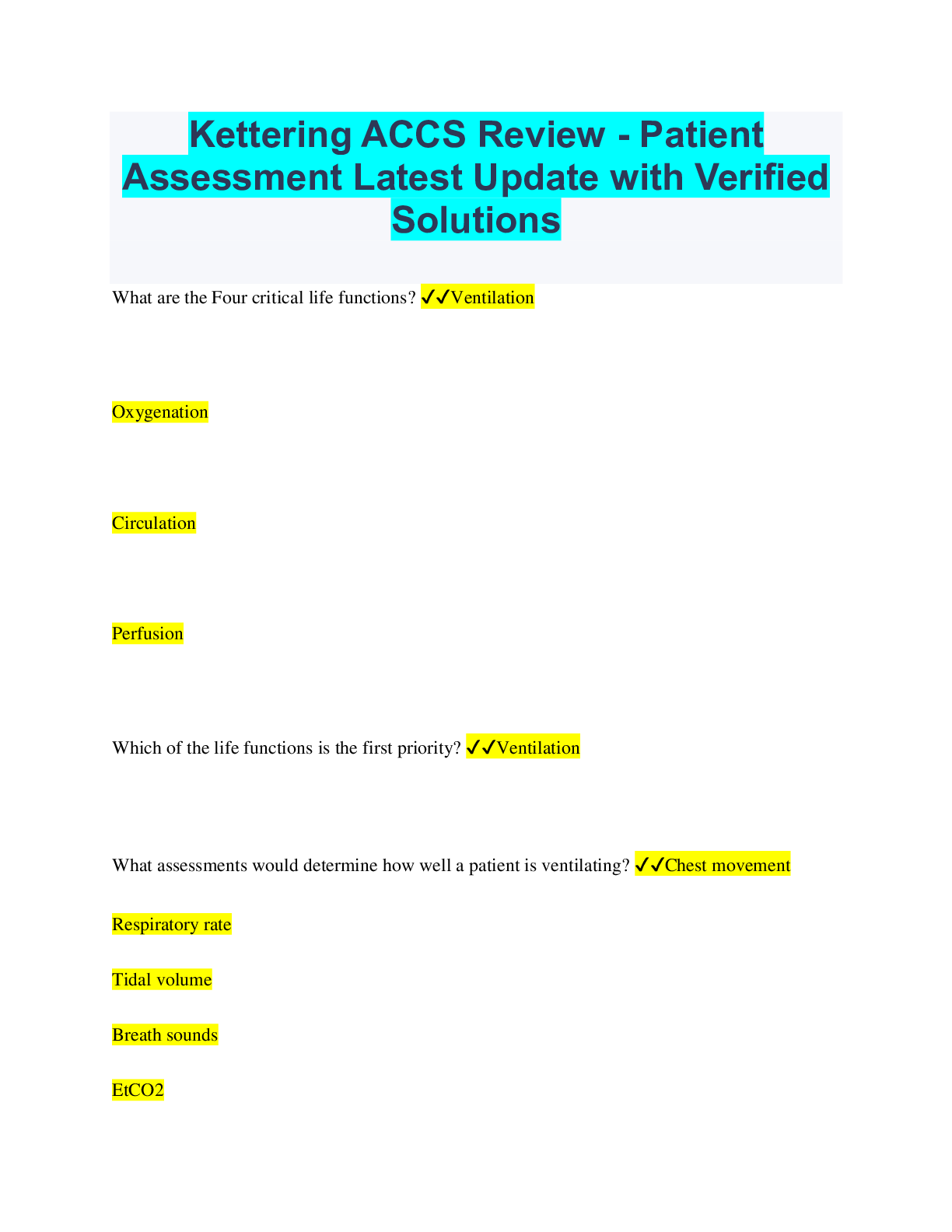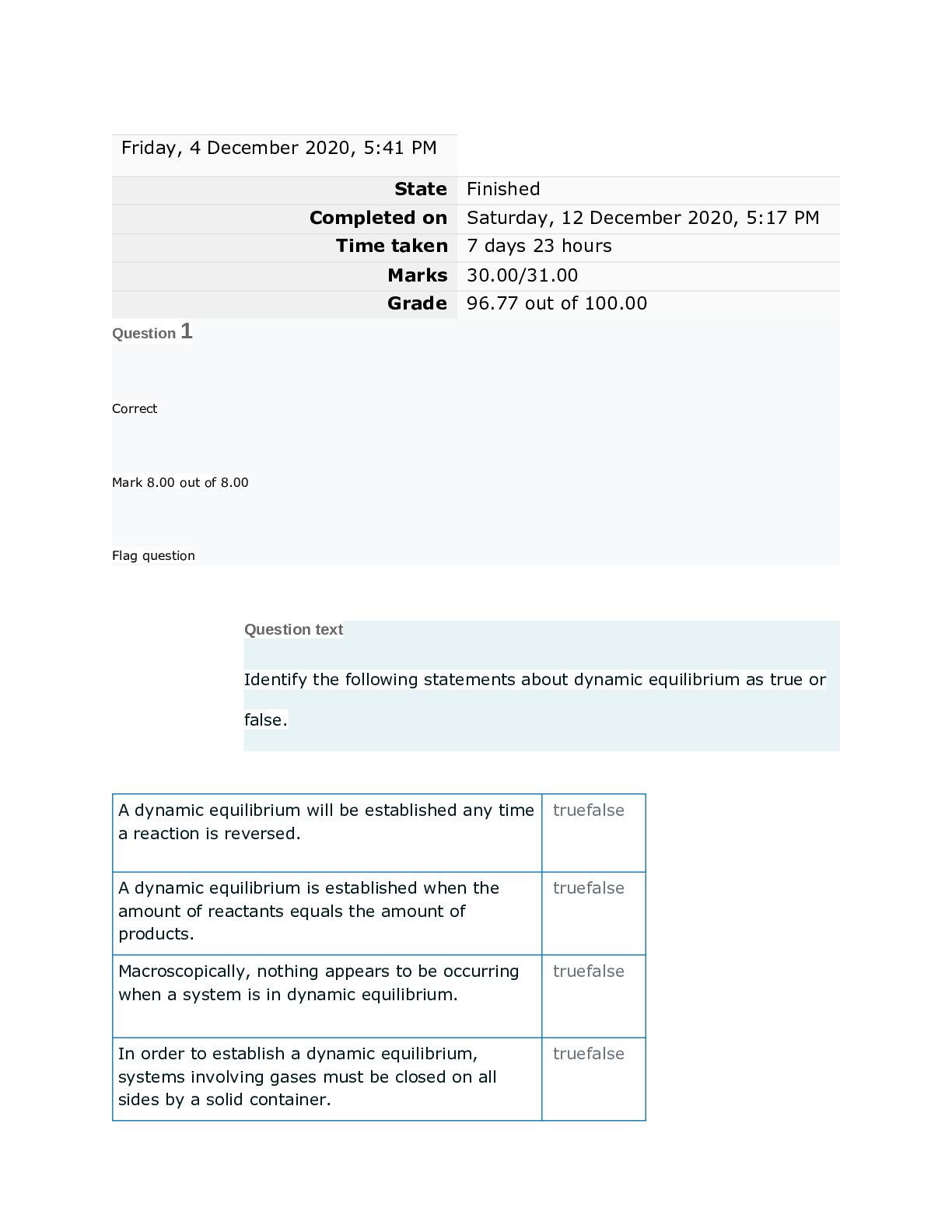Social Sciences > QUESTIONS & ANSWERS > Kettering ACCS Review - Patient Assessment Latest Update with Verified Solutions (All)
Kettering ACCS Review - Patient Assessment Latest Update with Verified Solutions
Document Content and Description Below
Kettering ACCS Review - Patient Assessment Latest Update with Verified Solutions What are the Four critical life functions? ✔✔Ventilation Oxygenation Circulation Perfusion Which of the life... functions is the first priority? ✔✔Ventilation What assessments would determine how well a patient is ventilating? ✔✔Chest movement Respiratory rate Tidal volume Breath sounds EtCO2 PaCO2 How would the adult critical care specialist determine if a patient has a problem with oxygenation? ✔✔Heart rate Color Sensorium SaO2 PaO2 What information would help the adult critical care specialist determine if a patient's circulation is adequate? ✔✔Pulse/Heart rate and strength Cardiac output What changes would indicate that a patient may not have adequate perfusion? ✔✔Blood pressure Sensorium Temperature Urine output Hemodynamics The most common problems are associated with this critical life function... ✔✔Oxygenation Acute Respiratory Failure ✔✔The inability of the respiratory system to meet the oxygenation, ventilation, or metabolic requirements of the patient Three Types of Acute Respiratory Failure (ARF) ✔✔Hypoxemic Hypercapnic Mixed Hypoxemic Respiratory Failure may be identified by... ✔✔PaO2 <= 50 - 60 torr on room air SpO2 < 93% on room air PaO2/FiO2 or (P/F) Ratio < 300 A-aDO2 > 200 torr Most common cause - (V/Q) Mismatching Hypercapnic Respiratory Failure may be identified by... ✔✔PaCO2 >= 50 Torr Forced Vital Capacity (FVC) < 10 mL/kg Maximal Inspiratory Pressure (MIP) > -20 cmH2O Clinical Course for Acute Respiratory Failure (ARF) ✔✔Hypoxemic respiratory failure (low PaO2, low PaCO2) followed by hypercapnic respiratory failure (low PaO2, high PaCo2) as patient becomes fatigued. Clinical Manifestations of Acute Respiratory Failure ✔✔Altered mental status Increased WOB Bradypnea Cyanosis Diaphoresis Tachycardia Diagnostic test helpful in identifying the cause of ARF ✔✔Chest Radiograph Classification of ARDS Severity ATS/ERS Criteria(Old School) ✔✔Acute Lung Injury P/F Ratio < 300 ARDS P/F Ratio < 200 PCWP < 18 mmHg Diffuse bilateral infiltrates Classification of ARDS Severity Berlin Criteria (New School) ✔✔Mild ARDS P/F Ratio < 200-300 Moderate ARDS P/F Ratio < 100-200 Severe ARDS P/F Ratio < 100 Diffuse bilateral opacities [Show More]
Last updated: 2 years ago
Preview 1 out of 6 pages

Buy this document to get the full access instantly
Instant Download Access after purchase
Buy NowInstant download
We Accept:

Reviews( 0 )
$9.50
Can't find what you want? Try our AI powered Search
Document information
Connected school, study & course
About the document
Uploaded On
Jun 26, 2023
Number of pages
6
Written in
Additional information
This document has been written for:
Uploaded
Jun 26, 2023
Downloads
0
Views
120

.png)














.png)


.png)
.png)




